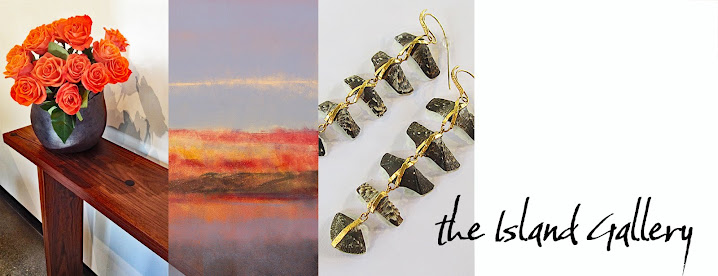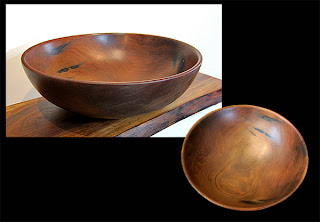Welcome to our October Gallery Picks Newsletter! We're featuring, once again, some of our current favorite art pieces, though it is always a difficult task to look around the Gallery and, with new items coming in every week, decide which ones to showcase - we love everything! Still, we must force ourselves to choose, so here we go. Don't forget to click on the links for each item to visit the online shop for a closer look and further details.
Enjoy!
Our No-Fail Recipe for Great Seating:
First: Locate several pieces of gorgeous walnut from Chico, California.
Second: Smooth and apply an impeccable finish.
Third: Hand-craft and attach unusual and artistic aluminum legs.
Result: Two fabulous benches.
These beautiful pieces are a collaboration, with the wood expertly finished
by one of our artists in Seattle. The aluminum legs were then
created by a Bainbridge Island metalsmith.
They're available singly (see
#1 and
#2) or as a
set.
Vibrant with color and appropriately titled Warmth, Jen reminds us of something
we will need in the upcoming chilly months! It's all very well to wrap up in
woolens, but being able to gaze at a blazing log, or a cheery painting like this,
can be equally therapeutic.
As with Jen's other works featured in the Gallery, it is oil on canvas.
From the Gitana Collection of fine jewelry we are delighted to showcase
these beautiful earrings of gemmy amber set in sterling silver. The clarity in these
stones is quite impressive, with their passing dark amber swirls and clouds.
A lovely gift, one imagines, for a special friend!
Rich color highlights this lovely vase from Bainbridge Island artist Fred Loase.
Fred is a fairly new artist to the Gallery but, we must say, one of our most
enthusiastic! He works in wood fire, raku, pit fire, and saggar fire, such as the
glowing example here.
But what the heck is saggar firing? So glad you asked!
Here's what we know about it:
A saggar is a lidded ceramic container.
It can be used in the firing of pottery for
several purposes: to enclose or
protect clayware during a firing from open
flame, smoke, gases and kiln debris;
and to create decorative markings on the
ceramic pieces.
To accomplish the
desired effects, pots are placed into saggars filled
with combustible materials
such as sawdust, straw, pine needles,
and/or wood shavings, as well as less
combustible organic materials:
salts, copper carbonate, copper sulfate, bismuth
(think Pepto-Bismol),
metals like copper or steel wire, and weird but non-toxic
materials such as
seaweed, crushed vitamin tablets, banana peels, and dog or
cat food!
Once the firing begins and
these materials ignite or fume, the saggars
provide a controlled atmosphere
which concentrates the effect of the
various materials on the surfaces of the
pots. This can produce dramatic
markings, with colors ranging from distinctive black and white to
flashes of
golds, greens and reds, depending on the materials used.
This firing process has been around for thousands of years and,
interestingly, "saggar" is a contraction of the word “safeguard”.
Visit more of Fred's wonderful work
here (we'll be putting up new pieces shortly).
Another of Begona Rentero's extraordinary pieces of jewelry.
In this piece and several of her new ones she has used an onionskin paper
that is very crisp (like autumn leaves) and extraordinarily lightweight.
The earrings for this design are definitely something to behold and
will be included online shortly (or ask us for a photo).
(They're glorious in Raspberry, by the way.)
What can we say about this amazing artist that hasn't
already been said?
Well, how about a quick mention of
the great honor recently given her:
Begona was selected to
participate as one of the fifty best emerging
and acclaimed jewelry artists in
the world by the Museum
of Art and Design
in New York City. Her work was included in
the LOOT 2013: Mad About Jewelry
show and sale, which
ran October 1-5 this month.
...Wait, did we mention that before,
too...?
Oh, that's right... right
here.
How do we love these salad bowls? Let us count the ways:
They're beautiful.
They're functional.
They're gorgeously and artfully made.
Their finish is food safe.
They come with their own salad servers.
Everyone loves them.
Dave's prices are amazing.
They're beautiful.
(Whoops...)
And they make GREAT gifts.
(Though we highly suspect some of you keep them for yourselves... naughty!)
(But we understand...)
All of that adds up to perfection in a bowl, shall we say!
More of Dave's magnificent bowls can be seen
here; and there
are more on the way, so keep an eye out for them in the web shop.
(P.S.: They're really beautiful...)
Fashioned from the softest cotton one can imagine, with sparkling Love Sails motif, these
pretty Tees come from one of our newest textile artists, Mary Jaeger. They come in all sizes
and several different colors; we have primarily black on hand at the moment, in
differing motifs, and some long-sleeved varieties; also some VERY special shibori-dyed
Tees, in long and short sleeves. Great for layering.
Mary also creates other stunning shawls, scarves, shirts, neckwraps and capes,
in some of the loveliest textiles we've seen.
 |
| Gold Delphic Sybil. Curt Labitzke |
Last but not least, an example of Curt Labitzke's amazing artistry
in this intaglio print inspired by ancient Greek, Etruscan and Roman art.
For a discussion of Professor Labitzke's fascinating work, scroll back
one blog post, or click
here.
That's it for October. Stay tuned as we ramp up for holiday shopping in November, beginning with the exhibit opening on First Friday, November 1st: Holiday Tables.
More about that very soon!
In the meantime, if you'd like to sign up to have notices of this and other events, sales and shows, send your e-mail address to
sr@theislandgallery.net and we'll deliver notices right to your inbox!
Oh, and on October 31st, please, please watch out for those little (and not so little) goblins and ghouls...





















